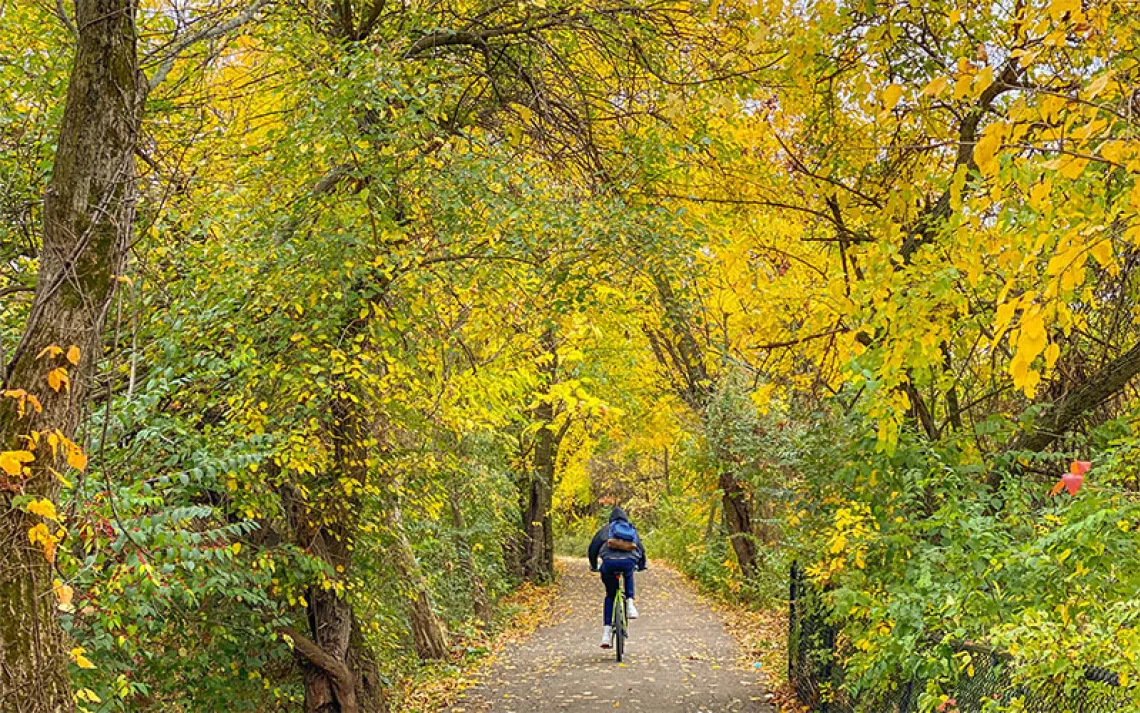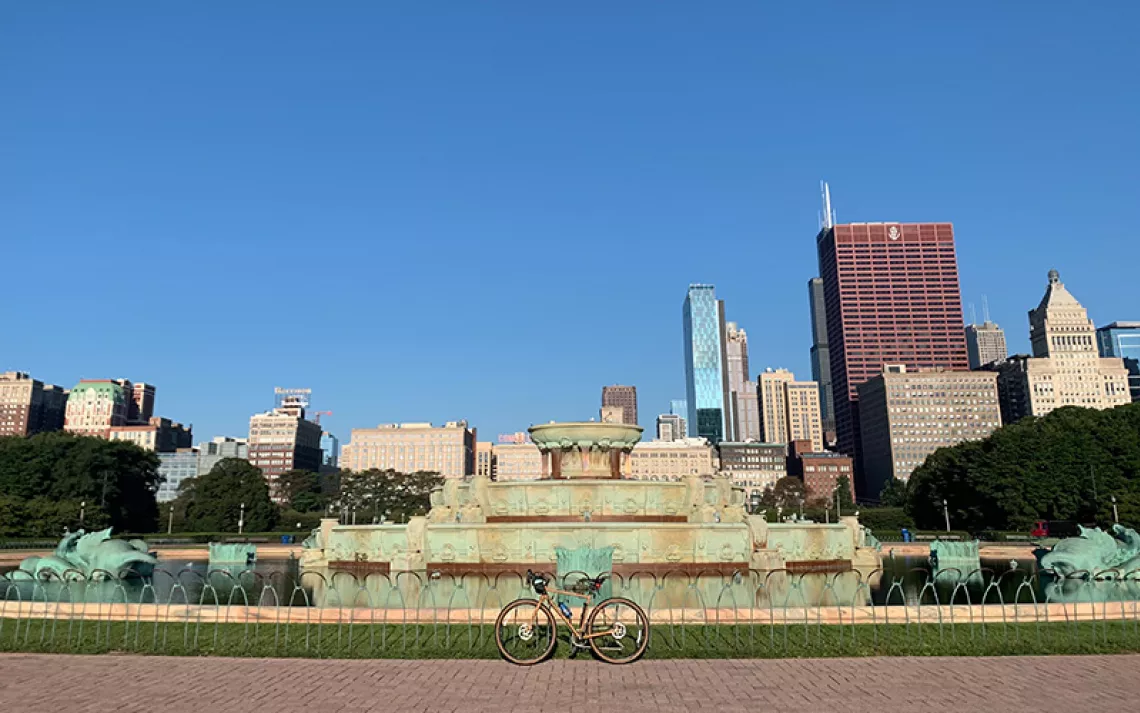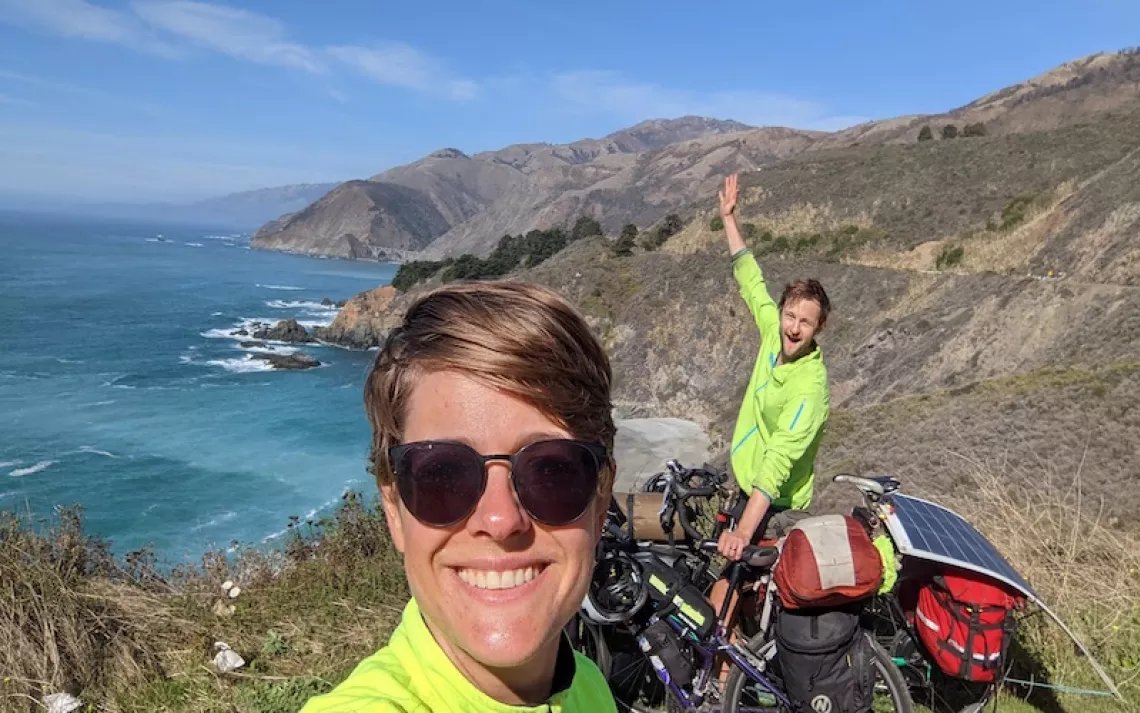Crossing a Great Divide
A cyclist reconsiders her views toward public lands
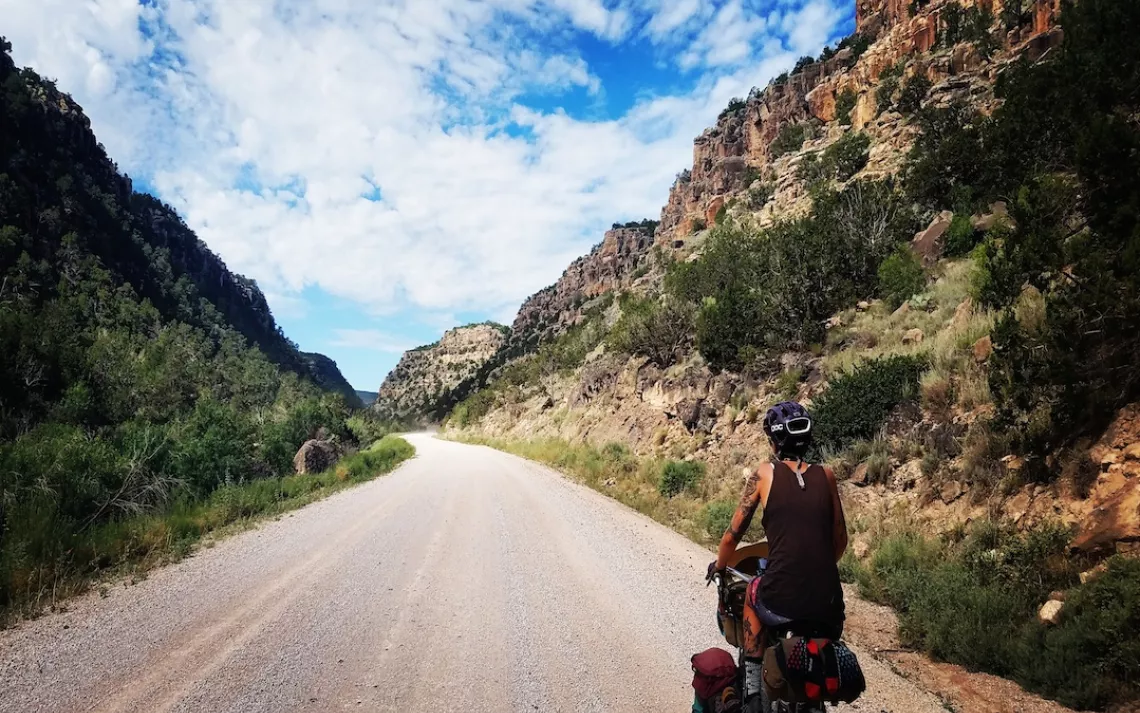
Photos courtesy of Carolyne Whelan
Throughout July and August 2016, I woke at sunrise and gazed out onto the remote expanse of North America’s Continental Divide. Two friends and I were following the Tour Divide, based on the Great Divide Mountain Bike Route (GDMBR), logging about 60 miles per day. Throughout the journey, Meghan, Taylor, and I felt wild and alone. As we prepared breakfast at various backcountry campsites along the route, we knew that just over the horizon, many others were utilizing the same national forests and Bureau of Land Management (BLM) public lands. But throughout our time traversing the GDMBR—which stretches from Banff, Ontario, to Antelope Wells, New Mexico (on the Mexican border)—our interactions with fellow humans were scarce.
As we pedaled down the continent, we met some on dusty washboard roads, where a pickup truck or four-wheeler might stop to offer us some cold soda, a shower, or a place to stay. Signs of people were everywhere, though subliminal—the dirt roads we pedaled were wide enough for cars, and occasionally we'd pass through a town, or camp in the “frontcountry” (i.e., at a designated campsite). In southern Montana and central New Mexico, cows blocked our passage, called out hauntingly at dusk and dawn, like monk chants played in reverse. Meghan sang back to them and they stopped, as if lullabied to sleep.
I’d always held firm beliefs on conservation and the American wilderness. But until I hit my mid-30s, I hadn’t cultivated a respectful understanding of the need for national forests and BLM land: Why wasn’t it all national park; why not preserve everything rather than allow for commercial use? I’ve been a vegan or vegetarian for 20 years, and my idea of cattle and ranchers was marred early on, thanks to PETA videos depicting factory farms’ sordid conditions. But out on the GDMBR, sharing a beer or some afternoon shade with ranchers, hunters, and other land users—finding common ground as lovers of the outdoors—my views softened, and slowly, my perception changed.
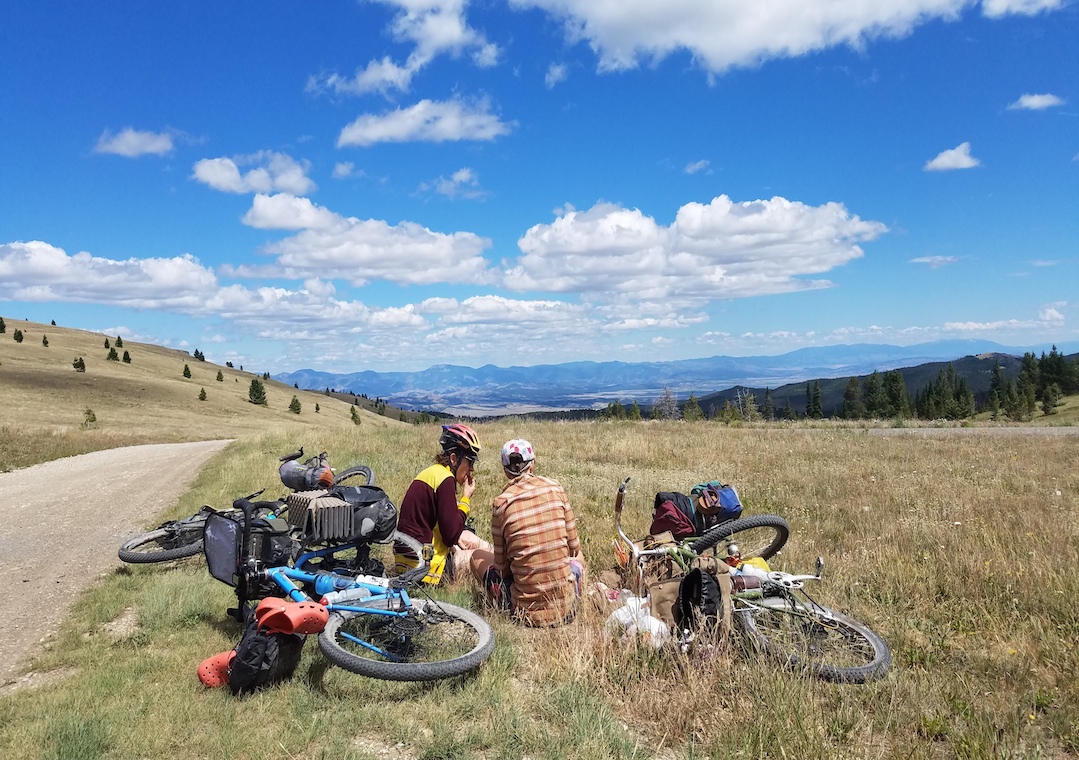
It took 2,700 miles and 50 days on a bicycle along North America’s crooked spine to realize the importance of breaking my hardline stance on conservation and instead advocating for the protection of the use of federal lands by all. With the new administration making baby steps toward turning federal land into state land—which historically has led to the privatization of land—I hope my newfound interest isn’t too late.
When wildfires subsumed large patches of Wyoming and northern Colorado, we diverged from the official route, navigating our way along the Idaho border for a few days while we sought out a safe route back to the race path. Eventually, the fires somewhat contained, we headed back toward Pinedale, Wyoming, where a family had offered us a place to sleep indoors. However, for a stretch of road, the fires were still close, and the air too heavy with smoke to inhale while cycling. We had to hitchhike.
Within a few minutes, a man named Kevin picked us up in his truck. Kevin runs a waste management company that provides porta-potties, porta-sinks, and toiletries to crews containing the wildfires (among others). As we drove through 65 miles of scorched forest that still burned in the distance, traversing Highway 191 between Hoback, Wyoming, and Pinedale, Kevin lamented the policy changes that had, to his mind, caused the fires.
“Logging was the main industry here,” he said. “But the environmentalists came in and, without knowing anything about the area, demanded an end to the cutting. But the loggers here targeted the old and sick trees, which have now been targeted by the beetles that chewed away at everything and then . . . well.” Kevin very well may have been referencing the Friends of the Earth protests in the late 70s and early 80s—although wherever there is logging, there are typically anti-logging protesters, too.
The smoke got thicker as we neared the firefighter camp, where we made a quick stop before continuing on into Pinedale. The station was abuzz with firefighters, smoke jumpers, and other crew members working to douse the flames we could see burning in the distance. We dropped off some crates of toilet paper, hand sanitizer, and other products and headed off once more, passing the scarred miles of what used to be aspen grove.
When one aspen gets sick, they all do. They are part of the same living organism, so the entire forest had become kindling at the same time. I struggle, myself, with logging. When I was a teenager, friends of mine traveled from around the country to the Pacific Northwest to sit within giant endangered redwood trees. I had dreams of joining them in the romantic battle to save the arbor giants. But as I learned on the GDMBR, it's not as simple as being for or against something. Kevin was a friendly, upbeat guy who also felt conflicted about the situation, though in a more direct way: His community was under direct threat of fire, yet he was paying his bills with his disaster relief support. While it’s easy to make a blanket statement against logging, there are many factors at play—arbor disease and beetle infestation, for instance. It’s a complicated relationship to navigate.
Soon thereafter, we reached the Great Divide Basin, an approximately 3,900-square-mile, mountain-surrounded space in Wyoming where moisture evaporates and the land is overtaken by sand dunes. I was kept awake by strong winds that levitated my tent, and the yips of coyotes we couldn't see; with no light pollution, even the full moon couldn’t illuminate the moonlike expanse surrounding our camp. There were no humans in sight, and little sign of them from the plateau where we camped. At daybreak, when we rationed a bit of water for oatmeal and coffee, we saw a white truck kick up dust on the path below our cliff. When it stopped suddenly below our ledge, two men got out of the truck, pointing at us. We'd grown feral during our weeks on the trail, skeptical of humans in the wild—especially of two men staring at us with binoculars—and backed away. When we eventually dared ourselves back to the edge, they were gone.
A few hours into riding that morning, we stopped to filter some drinking water at a marsh where cows grazed. Moss floated over green, pungent water: It smelled like mold mixed with rotting mammal carcass. As we began to filter our water, a truck bearing a BLM sticker pulled up. The men within were patrollers of this free land.
“You three riding the Divide?”
“Yeah. Not racing but riding the race route.”
“You, uh, shouldn't drink that water.”
As they retrieved water bottles from the truck’s cab, they explained that cows use the BLM space for grazing, and that across the basin, the BLM has installed wells, pumps, and reservoirs to provide groundwater for cattle and wildlife. The families that own said cattle, we learned, aren't typically part of huge cattle industries but simply contribute to area restaurants and lodges. The ones we stopped in each celebrated the local beef they used and boasted of personal relationships with their rancher neighbors.
As we rode farther, the wells all ran dry. For the last 28 miles of our two-and-a-half-day journey through the dusty basin, our water bottles were barren. We saw a few trucks carrying water for oil station workers, but none stopped for us. Mineral X and Vianium Mining trucks—cryptic reminders of the growing oil industry—passed, too. Most oil pumps in the southern part of the basin stood still. A few, however, bobbed solemnly up and down, like desktop wooden birds dipping into water glasses.
Within another day of riding, we exited the desert and entered Colorado, where the land immediately became more lush. Cows once more roamed remote dirt roads. I took a corner too fast and startled a nursing calf, who pulled away from her mother's teat in fear, milk spraying her face. The calf bolted, but the cow stood defiant, staring me down for a long moment before stepping aside to let me pass. That evening, we stayed at Brush Mountain Lodge, a backcountry oasis located conveniently on the GDMBR trail. Sitting around the fire pit, where we indulged in pizza and beer, we met the rancher who owned the cows we'd spotted over the past 15 miles.
“It's a hell of a job,” Bill the rancher said. He did some quick math to count his cows, which numbered in the hundreds, referring to some by name. “We were there for every birth, illness, and injury. We know every one of them; they're our family.”
“And you just use this land, or do you own it?”
“We own some of it, but the cattle roam into the public land.”
My mind slingshotted to the Bundy standoff of 2014, when rancher Cliven Bundy and other protesters had an armed standoff with the Nevada government over unpaid grazing fees and the trespassing of cattle on public land without a permit.
Bill is a fifth-generation rancher. Before that, he says, his family lived “just over the ridge.” For as long as can be remembered, they've maintained the land their cattle use for grazing. The cattle, he explains, have been a part of the ecosystem for as long as Bill's family, if not longer—affecting and sustaining the natural balance. The family, their cattle, and perhaps most importantly, their grazing fees are responsible for keeping this land public for the rest of us—sustaining the dirt and paved roads, the BLM workers, and the groundwater pumps that kept my small group alive and moving forward.
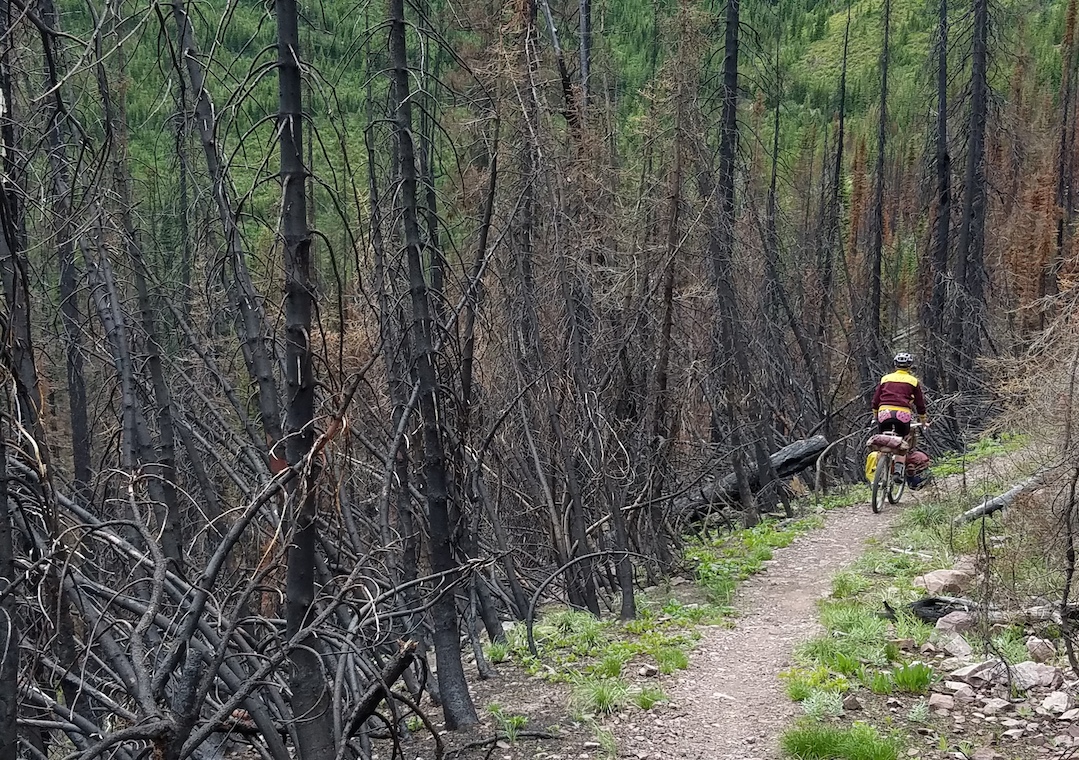
Since returning to the world of internet and new sources, I've found myself frequently confused and worried about the friends and animals I met out on the Divide. In southwestern Pennsylvania, where I lived from 2007 through 2016, water sources were poisoned by under-regulated fracking. Wyoming, too, has fracking. When I discussed this with Kevin after he picked us up at the side of the road, he expressed surprise that I was so upset at the idea. However, he became more upset when I told him that my former home state had almost zero fracking regulations, and claimed almost zero tax dollars, due to a pro-business deal between our former governor and the Marcellus Shale gas company.
Once land is in state hands, it’s easier for politicians to sell the land to private entities—and then, we all lose. Even if cattle can still graze in some areas, if the groundwater is polluted, cows won't have potable water sources. Communities could lose organic food sources, and families stand to lose their income. As loud and unsightly fracking drills and oil pumps populate once lush and expansive landscapes, small towns stand to lose the tourism dollars from hikers and cyclists.
Public lands are part of our national identity. Not just the Yellowstones and Joshua Trees, but the national forests and unnamed acres, and the dried lake beds where campfires burn into the night, illuminating lone campers and mud-caked bicycles.
 The Magazine of The Sierra Club
The Magazine of The Sierra Club

